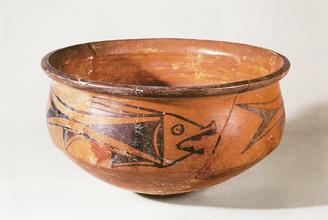Banpo Culture
半坡文化
Banpo Culture belongs to the Yangshao Culture of the Neolithic Age( about 10000 B.C. to 5 000 B.C. ),
半坡文化属于新石器时代的仰韶文化(大约公元前10000年——公元前5000年),
which originated in the middle valley of the Yellow River.
它发源于黄河的中部山谷。
As this culture was discovered in the vicinity of today’s Banpo Village, in Xi’an City in Shaanxi Province, it was named after this village.
因为这个文化在如今陕西省西安市的半坡村附近被发现,所以以这个村子的名称命名。
However, thousands of years ago it was not so called.
然而多年以前,它并不叫这个名字。
Primitive Banpo villagers lived 6 800—6 300 years ago, and they came from two different tribes.
原始的半坡村民生活在大约6800到6300年前,来自两个不同的部落。
In light of many kinds of farm implements and fishing tools excavated,
根据挖掘出的各种类型的农耕工具和捕鱼器具,
it is inferred that the Banpo people depended primarily on farming and fishing for survival.
可以发现半坡人主要依靠农业和捕鱼来生存。
At the same time, the Banpo people cultivated a colored Pottery Culture, one of the most representatives of Yangshao Culture.
同时,半坡人创造了一个彩陶文化,而彩陶文化正是仰韶文化最具有代表性的东西。
Their earthen wares were uniformly red in color and decorated with black pigment.
它们的陶器都是红色且以黑色颜料作为装饰。
The craftsmen had their potteries simply decorated, the most striking are the designs of fish that can be seen everywhere.
手工艺人们简单装饰他们的陶器,最引人注目的就是随处可见的鱼的图案。
The fish was finished in symbolic pattern.
鱼用象征符号所描绘。

It is concluded that fish should be the totem of ancient Banpo people.
由此可见,鱼是古代半坡人的图腾。
Here the masterpiece wares include: a tip-bottomed bottle, which is a water sucker under the principal of shifting gravity center (not really clear);
在这里,器皿中的杰作包括一个尖底瓶,它是一个吸水器,依据了重心改变(不一定如此)的原理;
and a painted basin with design of a human face holding fish at the corners of mouth.
还有一个着色的水盆,里面有一个人脸嘴角含鱼的图案。
Moreover, on certain similar parts of potteries are found twenty-two kinds of mysterious marks, which are estimated to be some primitive script.
不仅如此,在陶器的一些相似的地方发现了22中神秘的符号,这些符号被可能是某种远古的文字。
Meanwhile Banpo Culture witnessed the time of matriarchal clan society.
同时,半坡文化见证了母系氏族社会。
Women took a dominant position in everything and there were no permanent couples.
女性在任何事物中占主导地位,没有固定的伴侣。
After death, adult women and men were buried separately in communal graveyard,
去世以后,成年女性和男性被分别葬在公用的墓地,
having potteries and beads of animal bones as burial objects.
以陶器和动物骨头的粉末为陪葬品。
Children, however, were not allowed be buried with adults.
孩子却不被允许和成人葬在一起。
The mother would put the body of her child into pottery jar and bury it in a pit close to her house.
母亲会把死去的孩子放在一个陶瓶里然后埋在家附近的井里。
This special burial jar practice reveals that child was still not counted as the member of primitive community.
这种特殊的瓶中埋葬方式说明孩子仍不算远古社会的一员。
More burial articles were found in girl’s pit than in that of boys.
在埋葬女孩子的井里发现了比男孩子的井里更多的陪葬品。











